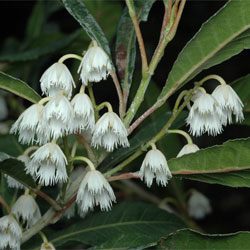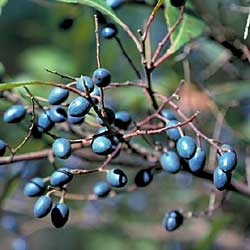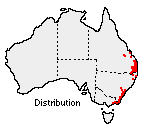Elaeocarpus reticulatus
 |
 |
Blueberry Ash, Fairy Petticoats, Koda
Elaeocarpus reticulatus (Blueberry Ash) is a strikingly beautiful and hardy plant, which has many uses in a range of horticultural situations.
Described as either a small tree or tall shrub, this evergreen species grows between 3-15m tall and 3-5m wide. It has a dense crown of foliage, and an approximately conical form. It needs little maintenance to thrive, surviving well in low nutrient and dry soils (although it performs best when well watered). This species grows in a range of light intensities, from shade through to full sun.
 E.
reticulatus is naturally found in a wide range of environments, from moist
gullies through to rocky ridge outcrops and sandy coastal scrubs. It is an endemic
Australian species, occurring all along the east coast from Fraser Island, Queensland
down to Flinders Island, Tasmania. The warmer temperate conditions along the
coast suit this species, and it is not found at cooler high altitudes or in
areas experiencing frosts.
E.
reticulatus is naturally found in a wide range of environments, from moist
gullies through to rocky ridge outcrops and sandy coastal scrubs. It is an endemic
Australian species, occurring all along the east coast from Fraser Island, Queensland
down to Flinders Island, Tasmania. The warmer temperate conditions along the
coast suit this species, and it is not found at cooler high altitudes or in
areas experiencing frosts.
The flowers and fruits are undoubtedly the loveliest features of this species. They often appear on the plant together, so providing a stunning double display. The extended fruiting season (April - October) often sees the fruit remaining on the plant into the next flower season (October - January). This special quality results in a long ornamental display of flowers, fruits or both together, almost all year round.
The masses of white and sometimes pinkish flowers are arranged in rows along the branchlets. They are cup-shaped with a fringed edge, giving them the dainty appearance of small hanging skirts, hence the attractive common name of 'Fairy Petticoats'. These small flowers, about 1 cm long, also have an unusual liquorice scent.
Another beautiful feature of this species is the round-oval drupaceous fruits. These are a stunning shade of bright blue, and resemble small (1cm long) olives. The most commonly used name of Blueberry Ash is derived from these pretty fruits, which attract birds like the Regent Bowerbird that collect them for their blue colour. Other birds that eat these fruits are Wonga Pigeons, Crimson Rosellas, Figbirds, White Headed Pigeons and Olive-backed Orioles.
This plant belongs to the small family Elaeocarpaceae, which has ancient tropical origins. E. reticulatus has retained some rainforest traits, such as a slightly flared or buttress trunk. The leathery leaves (to 12cm long) are lanceolate with a slightly elongate drip-tip apex and serrated margins. An interesting feature displayed in some of the leaves is a fine, whitish crust or film over the surface, giving the appearance of an evaporated salt layer. As the leaves age, they turn a bright red whilst still on the tree, providing an appealing colour contrast with the dark green foliage.
E. reticulatus can be used as a focal specimen tree for its flowers, fruit and foliage qualities. It also grows well in large tubs or containers. After pruning, it will resprout thickly, making it an excellent hedging plant. The new growth is an attractive pinkish colour.
Propagation is best achieved using semi-hardwood cuttings from around February through the warmer growing season. An application of IBA growth hormone (2000-4000 ppm) to the base of the cuttings can result in a 50-60% strike rate (pers. comm. John Nightingale, ABNG, Canberra, 2002). Germination from seed is slow and can take up to 2 years, although fermentation may assist this process.
The only pest problem which may affect this plant is various species of sawfly or spitfire larvae, which can defoliate the plant. Hosing the grubs off the plant and squashing them can avert this problem.
Text by Liz Brown (2002 Student Botanical Intern)
Name meaning: Elaeocarpus reticulatusElaeocarpus - From the Greek elaia meaning 'olive' and karpos meaning 'fruit'; reticulatus - Latin word meaning 'net-like' referring to the leaf venation. |
References
Field Guide to the Native Plants of Sydney - Les Robinson (1991) p.164.
Rainforest Trees of Mainland South Eastern Australia - A. G. Floyd (1989) pp.117-118.
Australia Native Plants -Wrigley and Fagg. 4th Edition (1996) p.528 (and p. 78 for pests).
Encyclopaedia of Australian Plants -Elliot and Jones. Volume 3. (1984) p. 388.
![An Australian Government Initiative [logo]](/images/austgovt_brown_90px.gif)

